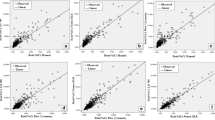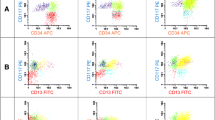Abstract
The evaluation of hematopoietic recovery after myeloablative chemotherapy in bone marrow transplant patients is based on sequential peripheral blood cell counting; particularly the absolute neutrophil count (ANC) >0,5xl09/l is the classical indicator of BM engraftment. The development of automated flow-cytometric analyzers has made available precise reticulocyte counts (RET) and the proportion of young, highly fluorescent reticulocytes (HFR) as accurate and early indices of haemopoietic recovery. We have studied 12 patients who received autologous PBSCT; peripheral blood mononuclear cells were collected after chemotherapy and rhG-CSF administration by repeated leukapheresis until a minimum of 4xl08 mononuclear cells. RET and percentage of HFR were obtained with the reticulocyte counter Sysmex-Toa R-1000. In our patients the three most useful indicators of BM recovery were HFR >5%, RET >20xl09/l and ANC >0,5xl09/l. Recovery of HFR >5% was obtained after a median time of 9 days, one day before recovery of RET and 4,5 days before recovery of ANC >0,5xl09/l; the rise of HFR fraction was the earliest sign of engraftment in 91,7% of our patients. In conclusion, these three parameters show an excellent predictive value close to 100% for monitoring of BMT engraftment in PBSCT.
Hematopoietic regeneration after myeloablative radiochemotherapy for bone marrow transplantation (BMT) is monitored by sequential peripheral blood cell counting. Until recently the earliest practical measure of the onset of recovery was absolute neutrophil count (ANC)1 Platelet count (PLT) is unreliable because of the many platelet transfusions given to most patients. Recent reports suggest that reticulocyte count (RET) performed by automated flow-cytometric methods is an early and accurate index of engraftment, especially if new indices which quantify the presence of young, highly fluorescent reticulocytes (HFR) are used.4,5,8,10,14 A great heterogeneity of threshold values exists in the literature as far as RET and reticulocyte subfractions are concerned, which makes the comparison of results obtained by different authors extremely difficult. Moreover, the transplant of stem cells collected by leukapheresis from peripheral blood (PBSCT) is characterized by very fast ANC and PLT recovery9,13,16, but RET and HFR have never been stdied in PBSCT patients.
The main objectives of our study were: 1) to define and compare the duration and characteristics of the hematopoietic suppression in PBSCT, in terms of peripheral blood cytopenia and supportive care requirements, in comparison with allo- and auto- BMT; 2) to determine the most suitable peripheral blood variables for the study of hematopoietic reconstitution; 3) to establish the clinical value of the selected variables in the monitoring of PBSCT patients.
Access this chapter
Tax calculation will be finalised at checkout
Purchases are for personal use only
Preview
Unable to display preview. Download preview PDF.
Similar content being viewed by others
References
Arnold R., Schmeiser T., Heith W. Frickhofen N., Pabst G. (1986) Hematopoietic reconstitution after bone marrow transplantation. Exp. Hematol. 14: 271–277
Beguin Y., Oris R., Fillet G. (1993) Dynamics of erythropoietic recovery following bone marrow transplantation: role of marrow proliferative capacity and erythropoietin production in autologous versus allogeneic transplants. Bone Marrow Transplant 11, 285 – 292
Bowen D., Bentley N., Hoy T., Cavili I. (1991) Comparison of a modified thiazole orange technique with a fully automated analyser for reticulocyte counting. J. Clin. Pathol. 44, 130 – 133
Davies S.V., Cavili I., Bentley N., Fegan CD., Poynton C.H., Whittaker J.A. (1992) Evaluation of erythropoiesis after bone marrow transplantation: quantitative reticulocyte counting. Br. J. Haematol. 81, 12 – 17.
Davis B.H., Bigelow N., Ball E.D., Mills L., Gibbons G.C. Ill (1989) Utility of flow cytometric reticulocyte quantification as a predictor of engraftment in autologous bone marrow transplantation. Am. J. Hematol. 32, 81 – 87.
Davis B.H., DiCorato M., Bigelow N.C., Langweiler M.H. (1993) Proposal for standardization of flow cytometric reticulocyte maturity index (RMI) measurement. Cytometry 14, 318 – 36
Davis B.H., DiCorato M., Bigelow N.C., Langweiler M.H. (1993) Proposal for standardization of flow cytometric reticulocyte maturity index (RMI) measurement. Cytometry 14, 318 – 36
Greinix H.T., Linkesch W., Keil F. et al. (1994) Early detection of hematopoietic engraftment after bone marrow and peripheral blood stem cell transplantation by highly fluorescent reticulocyte counts. Bone Marrow Transplant 14, 307 – 313
Henon P.R., Liang H., Beck-Wirth G. et al. (1992). Comparison of hematopoietic and immune recovery after autologous bone marrow or blood stem cell transplants. Bone Marrow Transplant. 9, 285 – 291
Kanold J., Bezou M.J., Coulet M. et al. (1993) Evaluation of erythropoietic reconstitution after BMT by highly fluorescent reticulocyte counts compares favorably with traditional peripheral blood cell counting. Bone Marrow Transplant. 11, 313 – 318
Kuse R. (1993) The appearance of reticulocytes with medium or high RNA content is a sensitive indicator of beginning granulocyte recovery after aplasiogenic cytostatic drug therapy in patients with AML. Ann. Hematol. 66, 213 – 214
Lazarus H.M., Chahine A., Lacerna K. et al. (1992) Kinetics of erythrogenesis after bone marrow transplantation. Am. J. Clin. Pathol. 97, 574 – 583
Pierelli L., Iacone A., Quaglietta A.M. et al. (1994) Haemopoietic reconstitution after autologous blood stem cell transplantation in patients with malignancies: a multicentre retrospective study. Br. J. Haematol. 86, 70 – 75
Spanish Multicentric Study Group for Hematopoietic Recovery (1994). Fow cytometric reticulocyte quantification in the evaluation of hematologic recovery. Eur. J. Haematol. 53, 293 – 297
Tichelli A., Gratwohl A., Driessens A. et al. (1990) Evaluation of the Sysmex R-1000. An automated reticulocyte analyzer. Am. J. Clin. Pathol. 93, 70 – 78
To L.B., Roberts M.M., Haylock D.N. et al. (1992) Comparison of haematological recovery times and supportive care requirements for autologous recovery phase peripheral blood stem cell transplants, autologous bone marrow transplants and allogeneic bone marrow transplant. Bone Marrow Transplant. 9, 277–284
Author information
Authors and Affiliations
Editor information
Editors and Affiliations
Rights and permissions
Copyright information
© 1996 Plenum Press, New york
About this chapter
Cite this chapter
Tommasi, M., d’Onofrio, G., Zini, G., Salutari, P., Sica, S., Leone, G. (1996). Reticulocyte Parameters as Early Indicators of Hematopoietic Recovery after Bone marrow Transplantation. In: Abraham, N.G., Asano, S., Brittinger, G., Maestroni, G.J.M., Shadduck, R.K. (eds) Molecular Biology of Hematopoiesis 5. Springer, Boston, MA. https://doi.org/10.1007/978-1-4613-0391-6_11
Download citation
DOI: https://doi.org/10.1007/978-1-4613-0391-6_11
Publisher Name: Springer, Boston, MA
Print ISBN: 978-1-4613-8031-3
Online ISBN: 978-1-4613-0391-6
eBook Packages: Springer Book Archive




